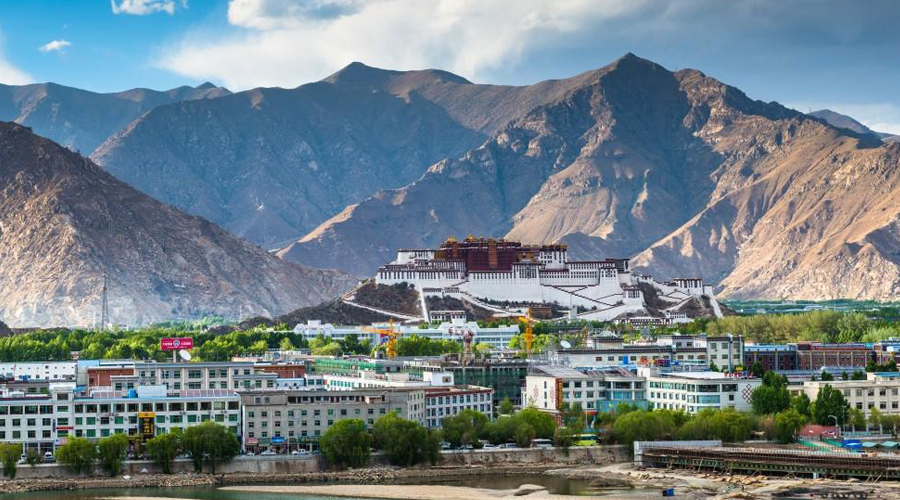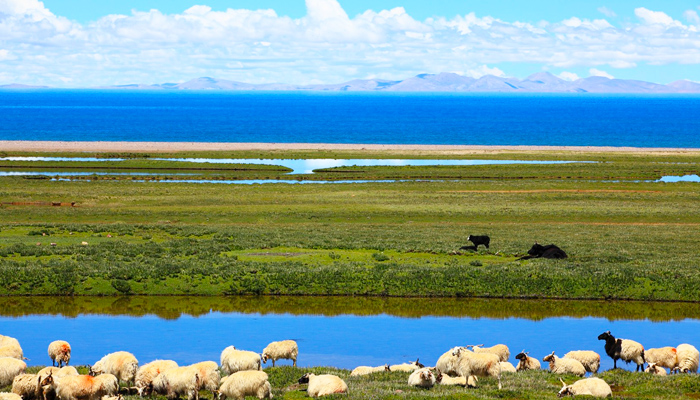
About Tibet (Autonomous region of China):
Tibet autonomous region of China situated at the Himalayan plateau in Asia, which is the highest region on the earth. The Tibet Plateau, at a 26°50′ to 36°53′ north latitude, 78°25′ to 99°06′ east longitude, it covers most of the area very dry and high elevation of 1.2284 million square kilometres. It is also known as the "roof of the world." Sunny valley Lhasa, Land of the god etc.
 Tibet borders Xinjiang in the north, Sichuan in the east, Qinghai in the northeast, and Yunnan in the southeast, it is bordered by countries and regions such as Myanmar, India, Bhutan, Nepal, and Kashmir, and has a land border of more than 4,000 kilometres. Tibet was incorporated into the People’s Republic of China, the previous Tibetan government abolished in 1959.
Tibet borders Xinjiang in the north, Sichuan in the east, Qinghai in the northeast, and Yunnan in the southeast, it is bordered by countries and regions such as Myanmar, India, Bhutan, Nepal, and Kashmir, and has a land border of more than 4,000 kilometres. Tibet was incorporated into the People’s Republic of China, the previous Tibetan government abolished in 1959.
There are over 800 settlements. Lhasa (alt. 3,650m.) is the capital of Tibet. The history of a unified Tibet begins with the rule of king Songtsan Gampo, his first wife Birkuti Princess of Nepal, who played an important role establishment Buddhism in Tibet.
At Tibet there are two Himalayan peaks above 8,000m. Mt. Everest and Shisapangma (Gosaithan) are located as border pillars between Tibet and Nepal. There are many other Himalayan peaks below 8000m. Tibet is the source of major rivers Yangtze, Indus, Mekong, Ganges, and the Yarlung (Brahmaputra) One of the famous pilgrimage sites Khang Rimpoche (Mt. Kailash) and Mansarovar lake situated in west Tibet, Nomad province at Himalayan region. The landscape around the mountain is rugged and dry.

 Visa and travel permit for Tibet: Travelling to Tibet it is important to issue Chinese visa from your own or neighbours country through Chinese embassy or consulate. Without visa all foreigners are not allow entry in Tibet from any border or airport.
Visa and travel permit for Tibet: Travelling to Tibet it is important to issue Chinese visa from your own or neighbours country through Chinese embassy or consulate. Without visa all foreigners are not allow entry in Tibet from any border or airport.
Also, you need a group visa Travel to Tibet. In one group require minimum four persons. For remote areas, such as Mount Kailash, Kharta Valley or Kham need special Alien’s Travel Permit issued by PSB of Tibet at Lhasa.
We have our own Travel Agent in Lhasa, for arrange the group visa, flight and train tickets and other necessary travel permits. For the Tibet group visa and permit we need a photocopy of your current passport (valid minimum 6 months) and white background, passport size photograph by email, at least one months before your trip to Tibet. After your arrival at Kathmandu, we require your original passport to collect the permit and group visa.
If your entry from mainland of China to Tibet by flight or train, our Tibet agent will send you your group visa details by e-mail, which you need to show at the airport or train before your departure to Tibet.
 How to reach in Tibet: There are several routes entry at Tibet by flight or by train as follows.
How to reach in Tibet: There are several routes entry at Tibet by flight or by train as follows.
1. From Kathmandu to Lhasa by trans Himalayan panorama flight.
2. Overland drive to Tibet from Kerung border.
3. Mainland China airport to Lhasa Gonggar airport (LXA) by flight.
4. Mainland China to Lhasa by Lhasa railway.
 Flights: There are direct flight to Gonggar Lhasa airport (LXA) from Kathmandu Nepal, Mainland China Beijing, Chengdu, Shanghai and Xining airport. Lhasa Gonggar airport is 60 km. away from Potala palace. The flight schedules can be changing any time, we request you, please check the flight schedules before planning your holiday.
Flights: There are direct flight to Gonggar Lhasa airport (LXA) from Kathmandu Nepal, Mainland China Beijing, Chengdu, Shanghai and Xining airport. Lhasa Gonggar airport is 60 km. away from Potala palace. The flight schedules can be changing any time, we request you, please check the flight schedules before planning your holiday.
Lhasa railway: This is the highest elevation train in the world, drive via Tanggula 5,068 m. and the highest tunnel in the world 4,905m. There are three different kinds of train tickets, normal seat, hard sleeper and soft sleeper.
Soft sleeper is more expensive than hard sleeper, because there is four berth compartment 75cm / 190cm beds with window. If you are traveling with your families or four persons it will be your own privet room with door. In peak season it is really difficult to get the soft sleeper tickets. We recommend taking either soft sleeper or hard sleeper according to your budget.
 Meals and drinking in the train: You can get three meals a day and drinks from the dining carriage located in the middle of the train.
Meals and drinking in the train: You can get three meals a day and drinks from the dining carriage located in the middle of the train.
Usually, only Chinese dishes are available onboard. It costs about 20 CNY per meal. You can pay by cash, Wechat, and Alipay.
There are also trolleys loaded with food and drinks served in each compartment. You can buy food and snacks from the staff onboard. If all that Chinese food is not your taste, you can bring some instant noodles, you can get free boiled water from a hot water dispenser near the sinks on board.
We suggest you bring some snacks, fruits, cookies, chocklets, biscuits and drinks it will be much better during your railway journeys.
Tours and trekking season: For tours and treks in Tibet, the best season is May to October. Winter tour could be comfortable, which is depending on the region and tours route. In winter most of the high passes motor road may blocked heavy snow ice. June to September is the peak season for Tibet.
 Accommodation and meals at Tibet: There are several Tourist-standard stars hotels and restaurants are available in major cities Lhasa, Tsedang, Gyantse, Xigatse and Lhatse.
Accommodation and meals at Tibet: There are several Tourist-standard stars hotels and restaurants are available in major cities Lhasa, Tsedang, Gyantse, Xigatse and Lhatse.
At the Everest base camp Zha Rongbuk and Mt. Kailash region at Darchen, Purang Taklakot and Manasarovar there are several guest houses and local restaurant for the accommodation and daily meals. At the restaurants you can get Tibetan, Chinese, Nepalese and Continental dishes. Even there are several street foods markets at the main cities, where you can get fresh and delicious meals.
Rescue and insurance in Tibet: For all travel, trekkers and climbers in Tibet, need their own personal travel insurance, either obtained in their home country or in Kathmandu. Full travel insurance should cover cancellation or interruption to the trip. There are Hospitals and medical services available in major cities.
The following few treks and tours programs are only for your idea and short information. We can arrange other treks, tours and Himalayan expeditions as per your planning and date at any region in Tibet which is open for tourist.
For more information about your future holidays trip to Tibet, in reasonable package cost please contact us.
Tibet time: At Tibet and China one official zone which is +8 hours ahead of UTC. the time zone is known as Beijing time. There are no day light saving and clock changes.
Local currency: The currency in Tibet is the Chinese Yuan (Renminbi). Bank notes come in denominations of 100, 50, 20, 10, 5 and 1 yuan.













